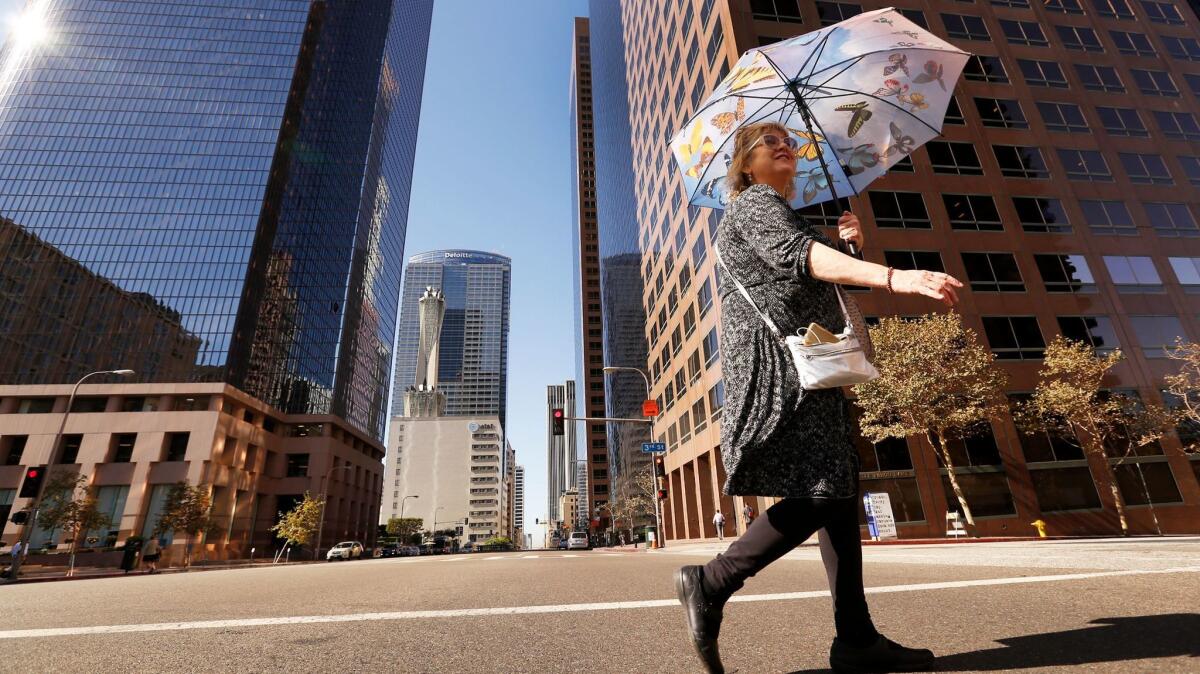After its rainiest winter on record, L.A. braces for heat

After months of uncharacteristically soggy weather across the Southland, Mother Nature will bring more unusual weather this weekend., the National Weather Service said.
Temperatures Sunday and Monday are expected to climb into the upper 80s, a full 20 degrees warmer than average for downtown Los Angeles in March, said Stuart Seto, a weather specialist with the National Weather Service.
The heat marks an abrupt change from what has been record-setting wet season for the region — and the state — through February.
Though no rain is forecast for the next week, federal records show that California is having its rainiest water year since record-keeping began in 1895 — a phenomenon that has lifted tens of millions of residents from drought.
It has rained 27.81 inches across the state, on average, from Oct. 1, 2016, to Feb. 28, the National Oceanic and Atmospheric Administration’s National Centers for Environmental Information reported. A water year begins on Oct. 1.
The 20th century average was 15.5 inches in the same time period and the previous record was the winter of 1968-69, when it rained an average of 27.34 inches, the agency reported.
After five years of drought, the results of all the rainfall have been nothing short of historic.
As of Friday in downtown Los Angeles, it has rained 12.55 inches since Jan. 1, while the average is 7.87, the National Weather Service said. Since Oct. 1, it has rained 18.5 inches downtown, and the average is 11.9, the agency said.
Data at Long Beach Airport shows a similar increase this year. The average rainfall from Jan. 1 to Friday was 14.1 inches, more than double the average of 6.42, the weather service said. It has rained 19.3 inches at the airport since Oct. 1, while the average is 10, data shows.
“All that rain we got knocked us down pretty good in the drought severity,” said Seto of the National Weather Service.
According to Thursday’s U.S. Drought Report, only 7% of California remains in moderate drought conditions and 1% remains in severe drought. No portion of the state can be categorized as being in extreme or exceptional drought. About 15% of the state is considered to be “abnormally dry,” according to the weekly report.
The state’s drought outlook is a turnaround from this time a year ago, when 99% of California and 37.1 million of its residents endured some category of drought.
As of Thursday, only 10.2 million Californians were living in some form of drought, according to report authors.
The drought turnaround began in October, when rainfall hit four times the annual average for that month.
Since Oct. 1, California has been soaked by some 30 atmospheric rivers — Pacific-based storms that are 250-miles wide and can hold as much water as the mouth of the Mississippi River.
But it’s unclear just how much rain is left for California this year. The traditional rain season ends in March and the NOAA’s Climate Prediction Center forecasts a bone-dry summer.
“Our precipitation is going to start declining rather rapidly after March. The good news is you have a great snowpack,” said Climate Prediction Center meteorologist David Miskus.
The Sierra Nevada snowpack sat at 178% of average Friday. The range provides about a third of the state’s water when its snow melts over the spring and summer.
For breaking California news, follow @JosephSerna on Twitter.
ALSO
Damaged Oroville Dam spillway may need to be used by next week, state officials say
Earthquake on the beach: Scientists think a 7.4 temblor could reach from L.A. to San Diego
This is what the storm damage in Yosemite looks like, and this is what it means
More to Read
Start your day right
Sign up for Essential California for news, features and recommendations from the L.A. Times and beyond in your inbox six days a week.
You may occasionally receive promotional content from the Los Angeles Times.







